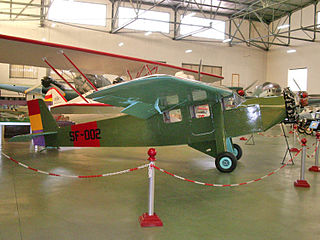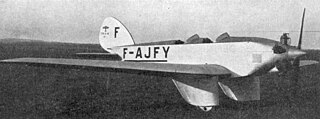Related Research Articles

The Farman F 400 was a 1930s French three-seat cabin high-winged monoplane which was designed and built by Farman.

Between 1920 and 1951 the Société des Moteurs Salmson in France developed and built a series of widely used air-cooled aircraft engines.

The Caudron C.280 Phalène ("Moth") was a civil utility aircraft built in France during the 1930s. It was a high-wing braced monoplane of conventional configuration with fixed tailskid undercarriage. The pilot and two-three passengers were accommodated within an enclosed cabin. The structure was wooden throughout, with the forward fuselage skinned with plywood, and the rest of the aircraft fabric-covered.

The Farman F.500 Monitor was a 1950s Franco-Belgian two-seat training aircraft.

The Farman F.190 was a utility aircraft built in France in the 1920s and 1930s. It was a high-wing, strut-braced monoplane of conventional configuration with a fully enclosed cabin and fixed, tailskid undercarriage. Popular both as a private aircraft and in the air taxi role, some 30 examples were also operated by airlines in France and elsewhere in Europe. Fifteen of these joined Air France's fleet in 1933 from the fleets of the smaller airlines it had absorbed.

The Farman F.230 and its derivatives were a family of light touring aircraft built in France in the 1930s. They were low-wing cantilever monoplanes of conventional configuration, with fixed tailskid undercarriage and two open cockpits in tandem. The thick-section wing used on these designs was a distinguishing feature.

The Caudron C.230 was a sporting, touring and trainer aircraft produced in France in 1930. It was a conventional biplane with single-bay, unstaggered wings of equal span. The pilot and a single passenger sat in tandem open cockpits. It featured a wooden fuselage with plywood skin.

The Caudron C.190 was a French two-seat low-wing single-engine sports plane, built by the French aeroplane manufacturer Caudron in the late 1920s. The only variant of the C.190 family (C.190/191/192/193) to be built in series was the C.193.
The Farman F.30A C2 was a two-seat biplane designed as a fighter in France in 1916 and powered by a single, water-cooled radial engine. It showed poor flight characteristics and only one was built, though it was modified twice. It should not be confused with the similarly named Henry Farman HF.30 of 1915, a completely different aircraft which was used in large numbers by the Imperial Russian Air Service.

The Farman FF 65 Sport was a French built light biplane, with a single engine and tandem seats, intended for sport and touring. First flown in 1919, it achieved modest sales at home and abroad in the early 1920s. Two unusual modifications produced a biplane glider and a low aspect ratio parasol wing machine.

The Farman F.90 was a single engine biplane transport, carrying 6 passengers. It was built and developed in France in the early 1920s. Though it had some competition successes, it was not put into production

The Morane-Saulnier MS.341 was a single engine parasol wing training and touring aircraft built in France in the mid-1930s. It had two open cockpits in tandem and was sold to private owners, clubs and the Armée de l'Air.
The Bloch MB.90 was the first all-metal French light aircraft. Only two aircraft were completed, making their first flights in 1932, though there were several variants.
The Caudron C.220 was a two-seat French biplane trainer. Only two were built, using different engines.

The Albert A-60 was a single engine, two seat, wooden sports monoplane designed and built in France in the early 1930s. Two were built and flown with three different engines.

The Dewoitine D.480 was a French single engine side-by-side sports and training aircraft built in the early 1930s. Two were completed and flew with several different radial engines. One remained active through the 1950s.
The Kellner-Béchereau 23 was a French two seat cabin touring aircraft, built in 1932. Its wing was constructed in a novel way. Only one was completed.
The Breguet Colibri was a low power, single seat French monoplane designed to compete in a 1923 newspaper-sponsored contest between such aircraft. Only one was built.

The Hanriot H.25 was a French, single-engined, six passenger airliner built in 1926. Only one was flown.

The Albert A-10 was a four-seat French transport aircraft which could be rapidly converted into an air ambulance. Two or three examples were built between 1929 and 1932, using at least two different engines, but neither variant reached production.